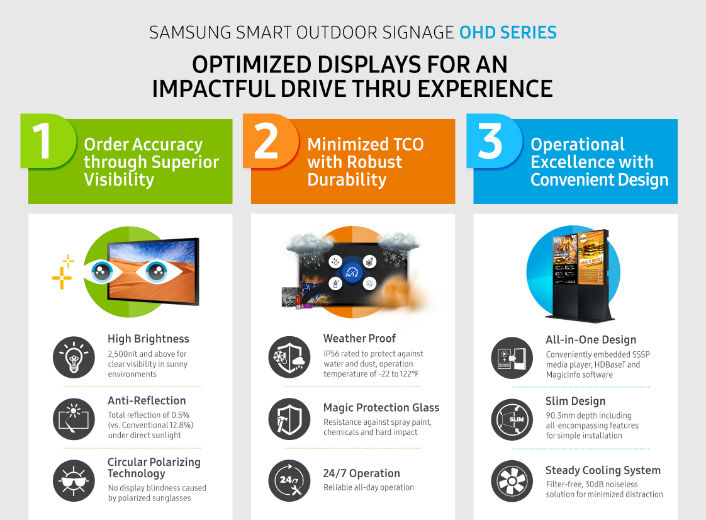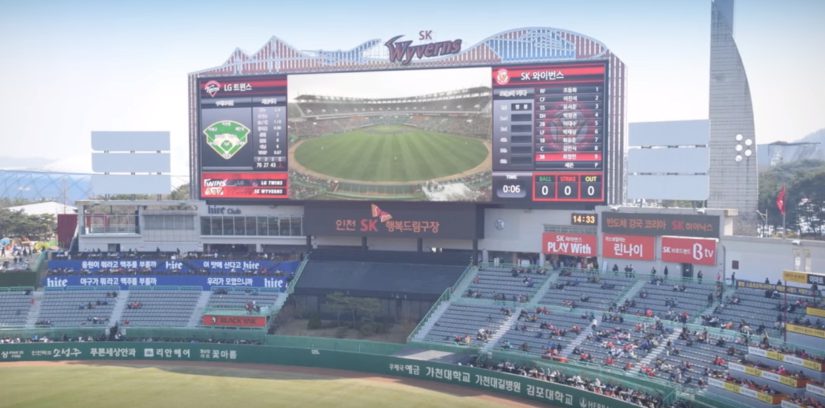Reading the Signs – Tips for Choosing the Right Outdoor Display for the Drive Thru
on April 16, 2016
While customers move through the drive thru lane, marketing and up-selling opportunities are quite literally passing them by. As outdoor signage continues to evolve, restaurants are seeking digital technology to engage this captive audience and capitalize on profit-maximizing and brand-elevating opportunities. To get the most out of an investment in digital drive thru signage, there are three main factors any restaurant should consider.
Superior Visibility
A customer, rushing to make the most of a short lunch break, pulls into the drive thru for a grab-and -go meal. Once she pulls up the ordering station, however, she realizes that the glare of the sun is making it impossible to read the menu. Frustrated, she orders some version of the usual, misses out on the special combo of the day, and vows to try the restaurant across the street next time. Outdoor digital displays have the ability to engage customers with compelling and relevant information—but only if that content can actually be seen.
One of the main concerns with early generation outdoor displays was the effect of brightness and glare on the readability of the content—something anyone who has ever tried to use a laptop outside can relate to. As Young Cho, a senior product manager from Samsung specializing in outdoor displays says: “The purpose of having the signage is to get the message through to the customer, so it’s important that the proper technology is implemented to make sure that any reflection is cancelled and people can actually see the content.”
This applies not only to the menu, but also to the order confirmation screen, since order accuracy is absolutely critical for customer satisfaction in the drive thru. Most indoor LCD displays have a brightness of 300 to 350 “nit”—a measure of luminance. For an outdoor display to be equally vivid in intense sunlight, outdoor digital signage must have at least 700-nit brightness.
Samsung’s OHD Series SMART Outdoor Signage provides this level of readability with LED backlighting, delivering vibrant content even in direct sunlight. These displays measure in at more than 2,500 nit, paired with energy-saving Auto Brightness sensors and an easily customizable brightness range.
High brightness is not enough, as glare from the sun also impairs visibility. Samsung’s outdoor signage is equipped with protective anti-reflection glass which reduces the total reflection to 0.5 percent and makes content clearly visible even under direct sunlight. Plus, the high contrast ratio of 5,000:1 creates an optimum viewing experience in any light, during any time of day or night. The displays are even equipped with circular polarizing technology, which means that customers wearing polarized sunglasses can view them without a problem.
Cost-Reducing Durability
With torrents of rain and wind swirling outside, your restaurant is empty. On days like this, you put your faith in the drive thru, where customers can grab a delicious meal without getting out of their cars and stepping into the pouring rain. Only two customers in, however, you realize that the graphics and text have shorted out in the inclement weather. The next day you wake up to a sunny sky and renewed hope, only to find that vandals have left a surprise message in bright yellow paint directly over your outdoor menuboard.
Now, instead of rejoicing over all of the sales you plan to recoup that day, you have to worry about the cost to repair your outdoor signage, along with worries about what your customers will think. By investing in outdoor digital signage with special tempered glass, you’re protecting against vandalism, spray paint, and hard impact—ensuring that promising mornings stay promising. You also decide it’s time to invest in outdoor signage that remains clear and high-performing in any weather.
“Digital signage has to resist the summer heat, winter’s freezing temperatures, pouring rain, and dust, among other things,” Cho says. “On top of all of that, it has to be protected from vandalism, so there’s a lot to consider.” Cho says that as a baseline, waterproof, IP-rated hardware is a must. Samsung’s IP56-rated, waterproof and dustproof design extends protection to the fan, drain hole, and power outlets, as well as the main display, while a steady cooling system eliminates the risk of overheating.
In addition to handling tough blows from vandals, Samsung’s outdoor digital signage is designed to handle tough blows from moody weather as well, with a temperature range of negative 22 degrees to 122 degrees Fahrenheit. By effectively protecting outdoor displays, owners can reduce repair costs and avoid risking lost sales opportunities resulting from inclement weather or environmental conditions.
Convenient Design
To make up for the past few days of lagging sales—and hopefully pay for the graffiti removal—the general manager has asked you, the IT manager, to immediately roll out a new LTO. He has also requested you update the calorie count for some of the menu items. With the old static signage, you would have had to go through a long process of designing, printing, and distributing the new content. With the new centralized content management system and digital outdoor displays, all of this work is simplified to a few clicks.
The ability to conveniently create, manage, and push out new content to outdoor digital displays is the final factor in building a successful outdoor display program. It’s particularly helpful if the same provider of the hardware can step in to provide this content-management software with a hard-to-beat, all-in-one system.
Samsung’s MagicInfo content management platform allows users to create, schedule, and deploy content to multiple displays in multiple locations. MagicInfo comes with a suite of creative tools, enabling brands to design eye-catching digital signage, all the way up to complex, interactive multimedia displays. The solution comes standard on Samsung SMART Signage products.
Furthermore, distribution of the created content can easily be distributed to the outdoor drive thru signage and managed in a centralized location due to an HDBaseT connection, which allows for smooth flow of content even over long distances. Samsung signage also comes with the industry’s first System-on-Chip (soc) embedded media player—the Samsung SMART Signage Platform (sssp)—which streamlines the process of uploading content and eliminates the need for external hardware to run digital content.
All of this is conveniently housed within a slim, stylish, compact design for easy installation. Measuring in at only 90.3 millimeters in depth, this signage includes an embedded media player, power box, cooling system, and more. With the clear benefits and increased selling power that outdoor digital displays bring, brands are looking for this trifecta of visibility, durability, and convenience to push their drive thru sales and accuracy to the next level.
Samsung continues to bring innovation to the next level with forward-thinking designs and capabilities, allowing restaurants to keep current customers happy while engaging the next generation. “We continue to study the dynamics of quick serves and the drive thru in order to develop optimized and impactful displays,” Cho says. “Our displays provide a unique business solution to fill the gap in the outdoor signage market by delivering industry-leading brightness and enhanced functionality, allowing business owners to create and deploy powerful and attractive messages easily.”
By harnessing the ability to relay information in creative, easily readable, and easily updated ways, outdoor digital displays are adding customer engagement and operator ease into the drive thru equation.
*This article contains content repurposed with permission from QSR magazine.


